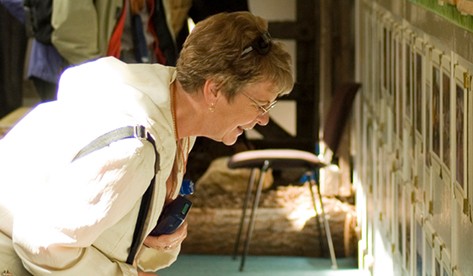
8th February 2024
Breaking Barriers on a Budget: A Practical Guide to Making Your Small Venue More Accessible
Museums, galleries and visitor attractions are gateways to culture, knowledge, and shared experiences and ensuring that everyone, regardless of physical abilities, can fully participate in and enjoy these cultural spaces is a crucial aspect of creating an inclusive society. This isn’t just a legal obligation; it’s a social conscience in action, a commitment to enriching the lives of all visitors.
Whilst financial constraints might pose challenges, embracing accessibility should not be a luxury for museums and heritage sites, but an essential investment as accessible tourism, in England alone, is worth £14.6 billion.
Even small venues with limited resources can take meaningful steps towards becoming more accessible and inclusive. From low-cost solutions for physical accessibility to creative methods of communication and engagement, we explore practical strategies that allow small venues to break down barriers and provide a truly welcoming environment for every visitor.
Here are some creative and resourceful ways to get started:
Physical Accessibility:
- Conduct a self-audit: Walk through your venue with an accessibility lens or even better consult accessibility experts, advocacy groups and disabled community members for their insights in helping to identify potential barriers like narrow doorways, stairs without ramps, or unclear signage. Remember the mantra Nothing About Us, Without Us.
- Prioritise low-cost solutions: Implement simple fixes like adding grab -rails in toilets, widening door openings slightly, and installing clear signage, especially think about lighting levels around your signs and using contrasting colours.
- Collaborate with local partners: Work with disability advocacy groups to identify improvement opportunities and handy volunteers to help with minor renovations or building assistive devices.
- Research public grants and funding: Many local and national organisations offer grants or funding specifically for improving accessibility in heritage institutions.
Communication and Information Accessibility:
- Develop written descriptions: Create clear and concise written descriptions of your exhibits, catering to different reading levels and learning styles. Consider offering these in printed form with a large font size and Braille as well as digitally on a mobile app or multimedia guide.
- Train your staff: Equip your staff with basic disability etiquette and communication skills. Encourage them to ask visitors how they can best assist and be open to adapting their communication style.
- Utilise free web accessibility tools: Explore free online tools like the WAVE Web Accessibility Evaluation Tool to check your website and online content for accessibility compliance. Make small but impactful changes like adding alt text to images and using headings and captions effectively. Take a look at our article Creating an Accessible Online Experience where we discuss meeting your visitor’s accessibility requirements before they even step foot inside your venue.
- Offer assisted tours: Partner with local sign language interpreters (registered with the National Register of Sign Language Interpreters) to offer occasional BSL tours or add a BSL or audio descriptive (AD) tour onto your existing multimedia guide or app. We talk about how we can help you enhance accessibility through digital content in a separate article that you can read here.
Engaging Diverse Audiences:
- Host inclusive events: Organise events geared towards diverse audiences, such as sensory-friendly hours for individuals with autism, touch tours for visually impaired visitors, or family-friendly activities accessible to all ages and abilities.
- Partner with local artists and communities: Collaborate with artists with disabilities or community groups to create inclusive exhibits or performances. This can enrich your offering while fostering valuable partnerships.
- Promote your efforts: Share your accessibility initiatives on social media, on your website and with local groups and invite visitors to share their feedback and reviews.
Remember, the key is to start small, prioritise impactful actions and involve your local disability advocacy groups in the process. Even with limited resources, small venues can make a big difference in building a more welcoming and inclusive space for everyone.
We have put together a video to share best practice from across the sector on how to improve accessibility for those who are deaf or hard of hearing, for people with sight impairments and for those with physical needs. We also asked them for their advice on how to get started. Take a look here.
Great storytelling (and a flair for the creative!) is at the heart of what we do and the expert teams at ATS can advise on the best way to bring your story to life. So get in touch for a chat!
For more information we recommend:
UK: https://www.visitbritain.org/business-advice/make-your-business-accessible-and-inclusive
Ireland: https://supports.failteireland.ie/courses/accessible-tourism/

